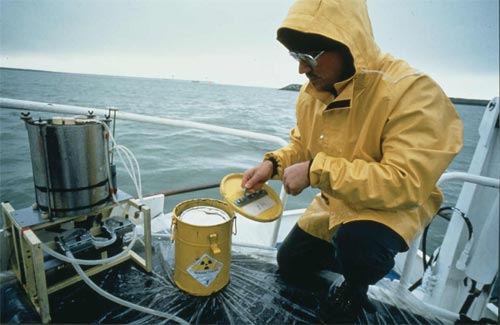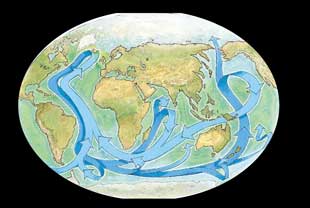Using atoms to understand natural phenomena
Before the days of radioactive tracers, chemical markers were used extensively in Earth and environmental sciences. It was through the use of fluorescein, for example, that the Doubs River was traced to its source in the Jura Mountains, and that it was proved that the Doubs and the mighty river that surged a few kilometers away were the same river.

Study of siltation of a channel
Opening a container with radioactive isotopes used in the measuring of sediment in access channels of Belgium’s Zeebrugge port.
© CEA/REA/LEIMDORFER
One of the main advantages of radioactive markers over chemical tracers is that radioactivity can be detected in far smaller quantities, making radiation sources far easier to detect in large bodies of water.
Researchers and engineers who work in the Earth Sciences frequently use radioactive elements that occur in Nature. They also monitor elements such as cesium-137 or plutonium that were released in the aftermath of the atmospheric nuclear bomb tests carried out in the 1950’s and that are still present.
In climatology, cosmic rays produce beryllium 10 nuclei when they pass through the atmosphere, nuclei which are then stored and left to decay in the polar icecaps. The comparative abundance of beryllium 10 can then be used as a measure of solar activity. When measuring samples of ice from different layers underground, climatologists can deduce information about the historical variations in solar activity – information which can be used to make predictions about future climate change.

Océanography
Radioactivity allows the monitoring of currents in oceanos. The cold, salty waters that sink into the depths of the oceans contain carbon-14 from the atmosphere. The study of the carbon-14 concentration in waters makes it possible to trace the ocean currents.
© CNRS
The colder streams that travel under the oceans often carry carbon 14 from the atmosphere into the deep abysses that exist underwater. This isotope then slowly decays, allowing oceanographers to use the carbon 14 concentration to trace the path of the oceanic currents.
For engineers, turbidity gauges (designed on the principle of gamma ray diffusion) measure in situ concentrations of sediment deposits in dams, reservois, port facilities and navigation channels. The collected information allows for the monitoring of the dams siltation of dams and to organize the dredging necessary to ensure the safety of navigation.
The operator in charge of the nuclear fuel reprocessing plant at La Hague in France have built 23 control stations to track the flow of krypton 85, a gaseous radioactive waste product with a comparatively short half life. Another underwater control station monitors continuously the amount of radioactive tritium present in the water at up to one kilometer from the outlet of the pipe which rejects liquid effluents. As in all such plants, the amount of waste product released is not allowed to exceed certain legal limits.